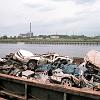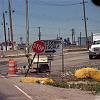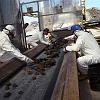
The Sorting Process
Arrival at Fresh Kills FacilityBarges delivered World Trade Center remains to the facility, where they were then unloaded onto dump trucks and driven up the hill to be processed. In December 2001, up to 17 barges a day, some capable of holding 650 tons, delivered material to Fresh Kills.
A Mountainous Gray Landscape
The 1.8 million tons of material that was once the World Trade Center was a jumble of human remains; pulverized concrete; bent steel; and burned and mangled office, store, and restaurant contents. A system developed to sift through the piles to retrieve human remains, personal objects, and evidence related to the terrorist attacks.
The Process Develops
At first, detectives and forensic recovery agents hand-sorted the material. Wearing Tyvek suits and other protective gear, they carefully scrutinized the material with rakes. During the summer of 2002, when all the piles were gone, the staff at Fresh Kills resifted through that material. Many additional remains and personal effects were recovered.
An Elaborate and Specialized Process
It was not until late fall of 2001 that a system used in commercial recycling centers was utilized at Fresh Kills. A long, round cylinder spun huge hunks of debris to loosen and separate fine particles from larger pieces. Once separated, the debris went onto a conveyor belt where New York City police and firefighters and Federal Bureau of Investigation agents searched for human remains, personal objects, and criminal evidence. Work could only be done in 45-minute shifts or the strain from watching the constantly moving material might result in vertigo.
Forensic Evidence and Recovery
The FBI Evidence Response Team evaluated all personal objects pulled from the conveyor belts before items were sent to the property trailer for cleaning, cataloging, and photography. A forensic anthropologist examined the suspected human remains to distinguish human from animal bone.
Some Significant Finds
Many objects, large and small, that were recovered from the debris intrigued the Fresh Kills team. Several pieces of art were found. A number of American flags, torn and battered, were found among the debris. Even small objects, such as souvenirs from the shops located at the World Trade Center, were recovered.
Vehicle Recovery
More than a thousand personal, government, fire, and police vehicles were utterly destroyed with the collapse of the World Trade Center. Some vehicles remained remarkably intact, while others were not even recognizable as automobiles or trucks. All vehicles were taken to the Fresh Kills facility and inspected.
The New York Police Department, the Port Authority of New York and New Jersey and the Federal Bureau of Investigation had an auto crime headquarters nearby. They recorded Vehicle Identification Numbers for insurance purposes and removed objects that were requested by the owner. The final tally was 1,195 automobiles, 102 pieces of fire apparatus, and 61 police department vehicles.













